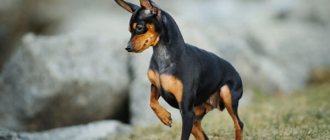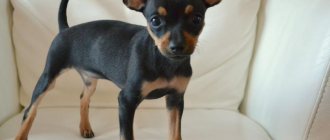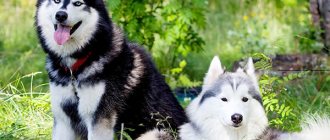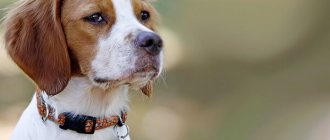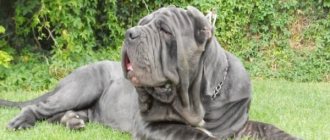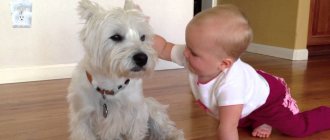The Russian Toy Terrier is a small, nimble, but timid dog.
It is distinguished by a small head with large, bulging eyes and large ears. Belongs to the decorative group.
There are two varieties of the breed - short-haired and long-haired.
We will talk about the long-haired variety in this article. You will learn about its characteristics, the specifics of care and nutrition, as well as how to choose the right purebred puppy.
Origin story
It is believed that the Toy Terrier was developed relatively recently, in the last century. But this is only true for the Russian Toy Terrier. The English breed dates back to the 18th century.
The first long-haired Russian Toy Terrier puppy was born on October 12, 1958 to short-haired parents.
The case did not go unnoticed; moreover, the breeders decided to consolidate this “trait”. The pet was matched with a friend who gave birth to exactly the same long-haired puppies. The experiment produced representatives of an interesting branch and gave rise to future breeding.
NOTE!
In 1988, a revision of the outdated standard for this breed was scheduled. In the new edition, the Russian Smooth-haired and Moscow Long-haired Toy Terriers were combined into one breed - the Russian Toy, which included both varieties.
So one puppy became the founder of a new variety among toy terriers.
Description of the breed
The Russian Toy Terrier is a small dog with an elegant build that easily compensates for its small size with arrogance and a predisposition to manipulate people.
Toy's ancestor is a true terrier, so the dog nips bad attitudes towards itself in the bud. The pet does not have a clear opinion regarding other animals and often becomes the initiator of conflicts, without thinking at all about the consequences.
Despite the fact that the breed is exclusively domestic, it is impossible to deprive Toy of walks and physical activity. With a lack of activity, the dog becomes irritable and capable of aggression, so it is important to give dogs the opportunity to “let off steam.”
Diseases
The “official” life expectancy of the Russian Toy Terrier is 12-13 years. In addition to heredity, errors in care and nutrition, illness and injury can shorten a dog’s life.
They “love” to cause problems to the ears and eyes. Infectious otitis is easier to prevent than to treat. Do not overcool your dog, regularly have your veterinarian tested for otodectosis, and clean the ears of dirt and wax. Allergic ear infections, like other forms of allergies, are rare in this breed. A veterinarian should accurately diagnose and treat inflammation of the ears, but you can help your pet even before visiting him: relieve itching, pain and inflammation with special drops.
The Toy Terrier's eyes easily become inflamed if they are not cleaned and not protected even from minor injuries. In addition, dogs of this breed are highly susceptible to cataracts. The drops only slow down the development of the disease, and over time the dog will either have to undergo surgery or come to terms with its blindness and loss of an eye.
Jumping from sofas, beds and similar furniture often results in a dislocated kneecap or even a broken paw bone for Toy Terriers.
Character traits
This is a playful and affectionate dog that quickly becomes attached to its owner. However, the breed is susceptible to stress, which makes it difficult to have toy terriers in families with children. The dog does not have a calm and patient disposition, so it can bite the offender.
IMPORTANT!
Despite his height, he is self-confident. Small pets often manipulate their owners to achieve goals.
These dogs are often picky when it comes to feeding, encourage owners to pay attention to them in every possible way, and will not give up the desire to mark their territory, denoting real estate rights.
Training
Toy terriers are taught order from an early age. The dog should not beg for treats, go to the toilet in the wrong place and bark for no reason. The puppy is clearly shown what is required of him, and the result is reinforced with a treat. An adult Toy is trained differently: he is scolded for unfulfilled commands and praised for his successes.
Dogs should not be trained by shouting and punishment. They will hold a grudge and will not respond to orders.
In addition, it is useful to teach toys standard commands: fu, come to me, next to me, sit, lie down. To prevent your pet from showing aggression towards other people's dogs and people, it needs to be socialized in time. It is best to start this process after the first vaccinations.
Accepted standard
The peculiarity of the breed is the compact size of the dog and thin bones. This is an elegant dog with long legs, whose weight does not exceed 3 kg, and the height at the withers barely reaches 28 cm.
Description of the breed standard :
- rounded head;
- prominent forehead;
- thin, triangular ears;
- weak cheekbones;
- a small nose, whose shade matches the color of the coat;
- square body format;
- Long neck;
- rounded loin and croup;
- legs are straight, with well-developed muscles;
- the hips are wide, but with weakly defined joints;
- the tail has a sickle shape, which is often docked;
- sexual characteristics are poorly expressed.
Expert opinion
Kozhevin Semyon Kirillovich
Expert dog handler.
A toy is a small pet with a small muzzle and large erect ears. This gives the impression that the pet is fragile, which is true, but only partly. In fact, the dog has well-developed muscles, and its body resembles a miniature Doberman. A distinctive feature of the long-haired Toy Terrier is the long locks and tassels that beautifully frame the ears. Smooth-haired toy terriers do not have this feature.
Caring for the Russian Toy Terrier
The semi-long coat of the Toy is easy to care for. Dogs do not require regular haircuts, just brushing their hair with a brush once or twice a week is enough. Use special spray conditioners for dogs to prevent hair matting. After each walk, give her a warm shower, and trim the claws on her front paws once every two months.
You don't have to walk your pet every day if it is trained to use a tray lined with newspaper or a diaper. In winter, especially on frosty days, avoid walking altogether. At the same time, be prepared for the fact that a pet that has not received enough exercise in the fresh air will be too active for an enclosed space.
Photos of colors
The most common colors:
- brown and tan;
- black and tan;
- lilac and tan;
- blue and tan;
- pale yellow;
- red with brown, black or without plaque.
The Russian Toy appreciates black, red, fawn and brown shades. Particular attention is paid to rich colors.
Advantages and disadvantages
Positive sides:
- cheerful;
- distrustful of strangers;
- get along well in an apartment;
- get along with family;
- highly trainable;
- do not require large amounts of food;
- They do well without long walks.
Negative:
- timid, aggressive, hysterical character;
- easily excitable;
- picky about feeding;
- susceptible to diseases;
- easily injured;
- often change roles in the owner-pet plan;
- freeze easily.
Life expectancy and health
The lifespan of these pets is reduced to 12-13 years, but this does not prevent dogs from overcoming the milestone at 15 years. However, much more often dogs die without living even half of their destined life.
Factors influencing the lifespan of a toy terrier:
- heredity;
- nutrition;
- care.
NOTE!
The breed has fragile bones, so dogs are prohibited from reaching peaks higher than 0.4 meters. Usually the limits of what is permissible are set by the ability of the dog itself, so it is not recommended to allow the pet onto a surface that it cannot jump to.
It is also advised to keep Toys away from large animals - dogs have no perception of their own growth, strength and potential.
These dogs also have a poorly developed sense of satiety, so it is important for owners to follow a diet and not indulge their pet. He can either become obese or lose weight.
In terms of teeth, it’s also ambiguous. As a rule, milk teeth are replaced by molars, but incidents occur in relation to teeth where the help of a veterinarian cannot be avoided.
Long-haired toy terriers are susceptible to diseases such as:
- diseases of internal organs;
- neurological diseases;
- problems with the musculoskeletal system;
- allergy;
- baldness;
- epilepsy.
Health
If you pay enough attention to the care and proper nutrition of your toy terrier, he will not have health problems. Most often, small pets are susceptible to the following diseases:
- ear infections;
- cataract;
- dislocation of the kneecap.
These dogs love to play at any age. In order not to injure them, children should not be allowed to play overly active games with them. You should undergo a timely examination by a veterinarian and vaccinate your four-legged friend. The first vaccinations are given at the ages of 2 months and 7 months. In the future, vaccination is carried out once a year.
The breeding characteristics of toy terriers are associated with the miniature size of these dogs. The first mating is especially stressful for them. Therefore, it is recommended to invite an experienced breeder or veterinarian for the first mating.
Basic rules of care
Despite the fact that this dog is long-haired, the Toy Terrier is not demanding in grooming. The owner only needs to use a comb or comb several times a week to prevent the formation of tangles.
You should bathe your pet no more often than once every 5-7 months and use a special shampoo for dogs. This is due to the fact that she has sensitive skin that is prone to dryness.
Grooming a pet
is a separate topic:
- the standard length of hair on the body is 3-5 cm;
- the fur adheres to the body, but does not hide the contours and curves;
- on the forelimbs the coat is shorter;
- the ears are covered with thick hair that covers the edges and tips.
To avoid diseases of the teeth and gums, weekly teeth brushing is required, but for this you purchase a special toothbrush and toothpaste.
Dog ears are affected by ear infections and ear mites, so regular inspection is recommended. Taking care of your pet also includes caring for the eyes, in the corners of which dirt accumulates. The eyes are examined and carefully cleaned of debris.
There are many toy terriers that are not able to sharpen their claws, so the responsibility is shifted to the owner, who is required to systematically trim them (once every 15-20 days). In this case, part of the claw is trimmed to avoid damage to the blood vessels.
Due to the weak coat and small body composition, the animal freezes easily, so in the cold season the pet is walked in overalls or a jacket.
Types - breed standard
Russian Toy Terriers are the smallest representatives of the species. They belong to the mini category and are divided into two types:
- Smooth-haired. The coat is short and lies tightly to the dog's body. The hair structure is smooth. There is no undercoat.
- Long-haired. The coat is moderately long, 3-5 cm. It can be straight or wavy, the main thing is that the pile does not hide the outline of the body. The hair on the paws is longer, and on the ears it forms characteristic tufts.
The smooth-haired variety was bred more than a hundred years ago in England, the long-haired variety was bred in the 50s of the 20th century in Moscow.
Breed standard:
- Dimensions of an adult dog: male height - 20-30 cm, female height - 21-28 cm.
- Weight of an adult dog: up to 3 kg.
- The body is oval, dry, with a pronounced transition to the withers.
- The tail is usually docked (undocked is acceptable).
- The chest is of moderate width, set deep.
- The skull is rounded, with a characteristic convex forehead. A clear transition from the forehead to the nose.
- The muzzle is sharp at the end, elongated.
- The nose is neat, small, pigmented depending on the color.
- The jaws are tightly clenched, with a scissor bite. The lips fit well to the teeth.
- The eyes are convex, quite large, dark in color, oval.
- The ears are set high, triangular in shape, erect.
- The neck is moderately long, with a smooth bend.
- The stomach is slender and lean.
- The limbs are thin-boned and straight. Paws are oval with closely pressed toes.
The Russian Toy Terrier is a graceful, well-built animal. His movements are confident and free.
Colors
The primary colors of the terrier are black and chocolate and tan. Selection work has diversified this palette. Now the dogs are colored tan blue, as well as red with splashes of black and brown. The shade should be pure and moderately saturated.
A violation of the standard is:
- white wool color;
- White spots;
- black;
- brown;
- blue;
- too saturated and excessively large scorch marks;
- zonal color.
Close attention is paid to the condition of the coat. A show terrier cannot have sparse, poorly growing hair. At the same time, too long and curly hair is considered a defect.
What and how to feed?
First of all, the owner should decide on the type of feeding.
In terms of natural products, it is recommended to adhere to a balanced diet. It is important for a dog to have vitamins, minerals, fiber and protein in its food.
The diet should include:
- chicken by-products, fish and meat (15-30%), chopped beef is also suitable;
- porridge (30%);
- vegetables (20-25%).
Toys love cabbage, carrots, cucumbers and beets, and don’t mind eating pieces of banana, apple and pear.
It is not recommended to abuse fermented milk products (once every 3 days); pets also do not digest milk well.
Remember that dogs gain weight quickly, so watch their diet and how much food your pet consumes. And don’t let them take someone else’s food, much less pick something up from the street or at a party.
Prohibited products:
- spicy, fatty, bitter, salty and fried foods;
- sour cream and butter;
- smoked meats;
- nuts;
- sweets, baked goods;
- egg white;
- sausages;
- spices.
If the choice fell on industrial food, then toy terriers need to choose premium brands and higher. You shouldn't skimp on your dog's food - cheap food can cause health problems for your pet.
IMPORTANT!
Whatever type of food the owner chooses, at first it is advised to leave the dog with the diet to which the pet has already become accustomed. The introduction of a new diet is gradual, over 1.5-2 weeks, to avoid the development of food stress.
Mating and birth
The first mating is carried out after the dog's third heat. Early mating is dangerous for the health of the mother and offspring.
It is strictly forbidden to breed smooth-haired and long-haired terriers. Puppies will be considered mixed breed and will not be able to participate in breeding.
The best moment for mating is the fourteenth day from the start of estrus. In addition, it is necessary to observe the dog’s behavior: it will show its readiness. Toy terriers weighing up to 1.5 kg are not allowed for breeding. The ideal weight for conception is 1.8 kg. During pregnancy, the girl will eat more than usual. The owner’s task is to provide her with a complete and varied diet, as well as a complex of vitamins and minerals. During the gestation period, the dog should be regularly examined by a doctor.
Childbirth in Toy Terriers is often accompanied by complications, so the presence of a veterinarian is vital. His duties will include cutting the umbilical cord, drying the puppies, suctioning excess fluid from the nose and mouth, and resuscitating measures. Toy terrier puppies often die during childbirth, so they may need urgent help, which will not be easy to provide. Only veterinarians have the necessary medicines and equipment.
Price range
On average, for a long-haired toy terrier puppy without documents they will demand 12-17 thousand rubles, a puppy with a pedigree costs more - 30-50 thousand.
The cost is also affected by gender and color.
In toys, gender is weakly expressed, but this does not deprive the bitch of the ability to reproduce offspring, therefore the price of girls is higher than boys. Among the colors, blue and tan and lilac and tan are distinguished; red is cheaper.
The problem is that it is difficult to find a pet in the advertisements that will meet every breed standard. If the future owner is interested in the potential of the pet (for example, to participate in exhibitions), then the best solution would be to contact the nursery directly.
Education and training
The sooner you start training a longhaired terrier, the better. A small but ill-mannered dog can become a big problem and exhibit:
- dominant aggressiveness,
- hysteria and picky eating,
- uncleanliness,
- cowardice,
- uncontrollability.
Include in your education program training for a litter tray, a specific sleeping place, clothing, and a transport bag; stop jumping on strangers, barking and growling for no reason, climbing on your knees, and entering the door before you. When training, you can limit yourself to a minimum of commands (“Place”, “Come” and “Fu”), but keep in mind that it will not be difficult for an intelligent terrier to learn them all (“Sit”, “Lie down” and “Stand”) and even circus tricks.
View this post on Instagram
Posted by @toy_terrier_lover Jan 21, 2022 at 9:21 am PST
Preparation for exhibitions
If you plan to exhibit your dog, you must prepare it accordingly for this. She must calmly tolerate a ring leash and a large number of unfamiliar animals and people around.
Basic skills of show dogs: running at the right pace, staying on a high table, standing on command, showing teeth.
When teaching him to run, balance your speed with the dog's, making sure he doesn't move too fast or too slow. The trot of an animal should emphasize its advantages.
Advice: try different paces of movement with your dog, from slow to fast, to choose the one that works best, and from now on always stick to it.
Russian toy terriers are displayed on tables. The difficulty is that small dogs are afraid of heights and jump to the floor. This will not only prevent the expert from assessing your pet's conformation, but will almost certainly result in injury to the animal.
Advice: do not use shock table training methods (fear of falling). Act only through rewards (treats). Don't stray too far from your toy.
Elements of a correct stance: natural positioning of the forelimbs, hind metatarsals perpendicular to the table or floor, neck straightened, head raised, slightly turned towards the expert, tail raised.
Advice: when teaching a stand, act patiently, with affection, and do not jerk or shake the animal.
Evaluation of bite and dental health is a mandatory point at any exhibition, so the dog should not be afraid or resist showing them to the expert.
Advice: accustom your dog to this gradually, starting with the usual touching of the lips, and only then to exposing the teeth, first the front ones, then the side ones.
View this post on Instagram
Posted by @toy_terrier_lover Jan 16, 2022 at 12:03 pm PST
What do the puppies look like?
Long-haired puppies have hair that stands up, making the pet look thicker.
In childhood, Toy puppies are plump and remain so for the first 3-4 months of life. They stretch out with age, becoming slimmer.
How to choose your future pet?
Kennels sell puppies 40-45 days old. At this age, dogs have already erupted their milk teeth and the pets are ready to move.
Before purchasing, the animal is examined for skin diseases, inflammation, and rashes. When choosing a pet, it is advised to pay attention to the paws (without curvature) and the tummy (should not be large and inflated). Puppies are characterized by cheerfulness and activity, so look for a puppy with shiny eyes and fur.
There is reason to be wary if:
- the puppy is not allowed out of the crate during examination;
- there are signs of strabismus;
- the pet has bulging eyes;
- no passport;
- discharge from the nose, eyes.
Standard color (black and tan)
Of course, it’s impossible not to start with it - black and tan is considered a classic and is one of the most popular.
There are clearly limited standard requirements for such dogs: the black color should not have any shades, and the tan should be in strictly defined places: on the face, on the ears, in the chest area and even near the temples.
But the nose, paw pads and edging of the eyelids must be black.
Not recommended! For breeding pure black dogs, if you plan to take the dogs to the exhibition!
But they also have their fans: such dogs look very aristocratic.
Black puppy (photo):

